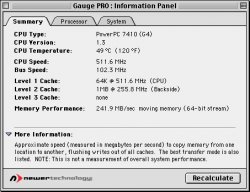I've been using Mflop instead of Gflop. Go check out Apple's G4 page. To clarify earlier tech errors from myself and others: G4 dual 800= 11.8 Gflops. That's still 6-10 times more data crunching per second than ANY OTHER PROCESSOR (card) currently available outside of refridgerator-size models.
G4 is 128 bit wide, not 64 bits. To the best of my knowledge, most other machines run 32 or 64 bits wide-yuck.
Total Impact is making expansion chassis' with up to 10 4-processor cards running G4 500's. If each G4 is worth a theoretical 5.3 Gflops than the Array would be around 212Gflops! The Linux core they use to run it all can handle more processors than that too!
G4 is 128 bit wide, not 64 bits. To the best of my knowledge, most other machines run 32 or 64 bits wide-yuck.
Total Impact is making expansion chassis' with up to 10 4-processor cards running G4 500's. If each G4 is worth a theoretical 5.3 Gflops than the Array would be around 212Gflops! The Linux core they use to run it all can handle more processors than that too!


